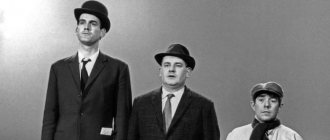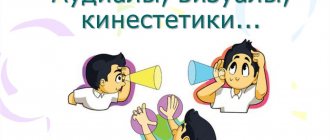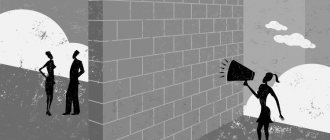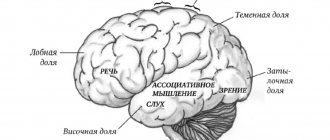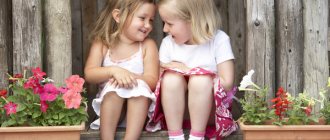Channels of perception
Channels of perception are a certain range of perceived information. Each person's channels of perception are developed in their own way.
In psychology and NLP, these channels are also called modalities. Although in NLP the concept of “modality” is somewhat broader than in psychology.
Note: NLP is neuro-linguistic programming.
In this article, information on the subject of consideration will be given in a general form, for informational purposes only. Simply, this information will be useful for understanding some of the processes occurring in the human body when performing yoga exercises (asanas).
We will talk about ways to obtain information. The methods of processing the received information belong to the representative system.
A person has five senses with which he perceives the surrounding material world: eyes, ears, nose, mouth, skin. (Some believe that there is a sixth sense organ - the vestibular apparatus, which is responsible for the sense of balance and body position in space).
Signals from the senses cause corresponding sensations. There are six external sensations in total. Five of them correspond to the senses: vision, hearing, smell, taste, touch (tactile sensations) and, additionally, kinesthetic sensations. (Motility causes sensations, although it does not have a separate sensory organ.)
Sense organs and motor skills are channels for perceiving information . As already mentioned, each person has these channels developed in their own way. They have different degrees of development. And since all processes in the body are interconnected, the way information is perceived affects a person’s behavioral and somatic reactions. (Note: soma is the body).
There is also a reverse influence of behavior and somatics on the channels of perception . This feature of the human body is used in yoga to develop the senses and the ability to perceive and display information.
Let's consider some channels of perception and the features of their manifestation at the level of somatics and behavioral reactions.
Stages of information perception during the lesson
using the example of a foreign language lesson
| relaxation | activity | relaxation | activity |
| relaxation method the goal is to introduce new material based on the student’s personal experience and choice | method drawing a symbol, image, information goal discussion of information | method listening to text goal understanding information | method reading text, analysis goal learning text |
| sensorimotor stage I | symbolic stage II | logical stage III | linguistic stage IV |
In the educational process, feeling and action in their individual choices are carried out in the process of educational relaxation. Moreover, if the role of stage 1 - presentation of information through an image can be called determining the further course of study, then the role of stage 2 - educational relaxation can be considered decisive.
It is at this stage that an individual choice is made: what and how to realize, accept, archive and send to the memory bank. The deep essence of the REAL method is the formation of the ability to work with mental images. So from the didactics of the traditional school we move on to autodidactics. In the REAL method, skills of working with an image are acquired (selection, presentation, drawing, structuring information and placing it in the image). Making a choice of one image or another, setting a priority initiates the skill of self-organizing spirituality and intellectual work.
A foreign language lesson using the REAL method consists of 5 main parts (we are not talking about time for checking homework here).
1. Phonetic exercise – 5 minutes (activity).
2. Introduction of grammatical material – 10 minutes (relaxation).
3. Discussion, drawing, writing on new grammatical material – 10 minutes (activity).
4. Listening (new text) – 5 minutes (relaxation).
5. Reading aloud, exercises – 5 minutes (activity).
This is a deeply educational technique. Each act of choice is accompanied by the acceptance of responsibility for this choice. Ontologically, education and education are twin sisters who were born and grow up together and at the same time. This is the situation when study itself is education by work, soul, intellect, and no additional time is required.
The criterion for the effectiveness of the methodology is the strength of knowledge, emotional effect, social time required to study the same course . If we compare the effectiveness (“E”) of the REAL method
and “E”
of the traditional
methodology for a given amount of work (“A”), then, relatively speaking, the denominator will be the total social work undertaken to organize and conduct the educational process – “a”. When comparing we get:
Our 30 years of experience shows that the effectiveness of learning when using the REAL method is 3 to 4 times higher than with traditional learning.
Experience proves that school-age students master the method of imaginative thinking most successfully. They like this because it is a natural way of thinking for humans. Let's look at the detailed outline of the lesson in the part that concerns learning new material. We do not consider introduction to the lesson (phonetic, lexical, etc. exercises, checking homework).
The considered lesson for students in grades 5–6 is designed for 45 minutes. We deliberately showed a lesson on the topic “Phonetics, vocabulary, morphology, syntax, grammar as components of the Russian language,” which, in fact, is not in the program in such a holistic, concentrated form. We pursued a specific goal - to show an element of creative interpretation of existing traditional material through a biologically adequate relaxation-active technique. Teaching the culture of intellectual work on the basis of the national culture of the people is a global task of pedagogy. This is what we tried to show using the example of one of the lessons.
The lesson contains those working stages that are accepted by traditional pedagogy and are well known:
I. Acquisition of knowledge.
II. Formation of the ability to use knowledge.
III. Consolidating the skill of using knowledge.
These pedagogical stages correspond to certain parts of the lesson, presented in the table “Schematic lesson plan” (see Appendix 1).
Stage I: acquisition of knowledge - takes place in a state of relaxation. During this stage, a mental image of the educational material is formed (for example, a flower with structured information). Stage time 10 minutes. (I-II points of the teacher’s actions - see Appendix 1.)
Stage II: the formation of the ability to use knowledge takes place in a state of activity (excitement). During this stage, the image of information is “raised” to the level of a verbal description, a visual graphic image in a drawing, and a visual, motor, auditory, and logical connection between abstract information and a personal image. Stage time 10–15 minutes. (III-VI points in Appendix 1).
Stage III: consolidation of the skill of using knowledge . During this stage, the educational image is “severed” from the textbook, a search for independent examples occurs, followed by (test) returns and corrections of the examples. Stage time is 10–15 minutes. (VII-IX points in Appendix 1.)
Homework is a continuation of stage III.
Experience shows that students love to create their own images. Many of them want to complicate the scheme or “spiritualize” the image. This process of comparing the new with the familiar and understandable was and is in the arsenal of many outstanding scientists. Be sure to use the 3 lesson steps! They are physiologically, psychologically and methodologically necessary. Skipping even one of them can be harmful for children, as if we “knocked down” natural biorhythms or made arbitrary exceptions to them: is it possible to imagine such exceptions, for example, in the cycle “morning - day - evening - night”? The lesson diagram shows that the lesson contains 9 parts, although there can be 3, 5, 10 - at the discretion of the teacher. So, if you carry out phonetic, lexical, logical exercises, then the number of parts of the lesson increases.
From the above diagram it can be seen that new material is repeated at least 5–6 times in 45 minutes, with each repetition one or another channel of perception is activated: in part III of the lesson speech is activated, in part IV – hand motor skills, touch, vision, smell; in V – logical memory structures, etc.
Finding the educational mental image in long-term memory and in active circulation is guaranteed with uncompromising adherence to the sequence of stages I – II – III and, of course, the personal enthusiasm of the teacher! Love (the field of unconditional positive perception by the teacher of the student) and the energy of the teacher generate the corresponding love and energy of the student’s educational mental image.
The real result of the work using the REAL method:
— reduction of time for studying the subject by 3–4 times;
— increasing interest in learning and improving study results;
- revealing the creative abilities of the guys - they will “bombard” you with new ideas.
Teachers of various subjects have been working in the REAL method for at least 15 years in the cities: Borovsk, Moscow, St. Petersburg, Mariinsk, Anzhero-Sudzhensk, Lyubertsy, Zhukovsky, Lobnya, Kovrov, Khabarovsk, schools in Buryatia, Yakutia, Kazakhstan, Ukraine [33 , 34, 59-61, 88, ,12-14, 44, 49, 54, 77-79, 92-94, 86, 95, 99, 101, 105-107, 109-115, 117-119, 128, 129, 142-144, etc.].
Awareness of involvement in emergent changes in education gives strength, confidence, and conviction to continue the creative work of a school teacher. Here are the words of some of them. “The seminar on noospheric education, in which I was lucky enough to take part, became the most interesting and unusual event in my teaching practice. I will try to competently apply the knowledge I have acquired in practice” (Mr. Kovrov). “I have always involved all sensory-motor channels of children’s perception in my studies. And now she has received the “scientific legs” of her actions. I'm happy!" (Sevastopol). “I have been teaching nature-based lessons for a long time. I really want children to live the information. You gave a scientific explanation for what I do” (Mr. Kovrov). “It’s so easy to understand now, knowing the laws of methodology, what needs to be done in class” (Moscow). One of the teachers in the city of Kovrov made an important conclusion for herself: “I was deeply worried about the following circumstance. I put all my strength and knowledge into my work. My intentions are the most lofty, why is the return so low? I was desperate. Having learned about the structure of the methodology system, I clearly understood the reason for the low efficiency of teaching work, I stopped tormenting and scolding myself. We need four components of educational methodology clearly focused on the Universal Laws of the World and the General Laws of Human Society: goals, teachers, methodology, and a formulated system of methodology. All this, and not just one thing, gives fresh blood to the veins of ancient pedagogy.”
Teacher L.M. Snigireva (Kharkov region) writes: “The bioadequate method allows each of us to see potential in ourselves and our students. Perhaps the widespread propaganda of this method will lead the creators of traditional textbooks to the idea that their creations (textbooks) are created for those who have just begun to learn about the world around them, and this world is bright, sonorous, and not as pale and colorless as those offered to children textbooks."
Children also enjoy the noospheric lesson. They open up deeper and learn to see the subject of the lesson in different ways. They listen to each other with pleasure: what “pictures” a friend created, what color the information is painted in; They are happy to draw their images. The lesson gives the child a boost of vivacity, a surge of energy, and a boost of imagination. In the next lesson everyone wants to answer.
Alexander Usmanov: “I was lucky to be the lucky one and feel the noospheric lessons myself. And my opinion is that our descendants will sit through such lessons. Children who have not tried this method of teaching, of course, have lost a lot.”
Masha Kapshuchenko: “After bioadequate lessons you don’t get tired, but on the contrary, you gain strength and relax, so your performance improves during the rest of the lessons.”
Alexander Pirogov: “When you absorb information in a bioadequate lesson, you don’t get tired at all, but on the contrary, you feel a surge of strength and energy. Thanks to this method, I learned to quickly relax or concentrate when I need it. And it seems that I have already begun to perceive any information in the form of vivid visual images. It is important for me to be able to generalize and systematize the knowledge that I receive in regular lessons. It really helps with remembering."
CHAPTER 8.
BIOADEQUATE TEXTBOOKS
In the modern world, the task of science and education is a simple, economical presentation of information. Teaching aids play an important role. Textbooks developed and tested by scientists of the Russian Academy of Natural Sciences are called biologically adequate. These textbooks are textbooks of a new generation. They organize material in a particular discipline as a system of vivid supporting images filled with comprehensive structured information in an algorithmic order.
The task of a bioadequate textbook is to organize the student’s personal experience in accordance with the physiologically necessary stages of perception and processing of information. According to the operational concept of intelligence by J. Piaget [86, p.55-237], any information is perceived by a person and goes through 4 natural stages:
IV
III linguistic
II logical
I symbolic
sensorimotor
(sensual (figurative “folded- (discursive- (accommodation of information-
perception” information-logical formation in consciousness through
tions) comprehension of the word-image, elaboration
information) at stages 1-3)
Scheme No. 17
This natural path of information leads to the formation and accommodation of mental images - holographic microstructures of thinking.[23]
In the textbooks of classical pedagogical science, information was presented only at the lexical and logical levels (with some reference to the symbolic stage). The physiologically necessary, sensory-motor and symbolic stages of information perception were practically absent in them. This is one of the reasons for the difficulties in understanding (or rather, perceiving) information by students. Without the necessary first and second stages, the action cannot be complete: running will be sluggish, thoughts will lead to insomnia, and we will find ourselves in the role of a fox, only dreaming of trying grapes. Compliance with the natural order of perception and processing of information leads to saving the necessary and sufficient time and energy in the educational process. Following the stages of information perception and their clear sequence are the basis for the structural parts in a new type of textbook. It is obvious that the structure of a bioadequate textbook is as economical as possible. It is subordinated to his goal and has 4 clearly expressed parts in each lesson.
1. An image of the phenomenon being studied (chamomile, apple, ear of corn, etc.) with educational information applied to it.
2. Text explanations for the image.
3. Consolidation exercises.
4. Creative tasks on the phenomenon being studied.
Each of these parts is aimed at solving a specific educational problem. It is important to emphasize that when working with a textbook, you cannot skip or change the order of following the stages of working with information.
Bioadequate textbooks
involve various channels of perception in the educational process: hearing, vision, smell, touch, taste. This is the second mandatory condition for the bioadequacy of the process of information perception from the point of view of human physiology. Relying on multichannel perception allows information to be stored in long-term memory. In the language of psychophysiology, it is to impose new information on the student’s personal experience through an associative series: symbol – feeling – word – logic. Try to check the validity of our statements. Open a page with any of the images in the textbook, for example, “Russian Language”[24]: apple, cherry, chamomile... What sensations do you have? What personal memories arose in connection with this or that image? In the same place where the sensation of taste arose, remember both the smell and tactile sensations; soon motor skills and spatial orientation will begin to work (where was it? who was nearby?), you will hear sounds or even remember someone’s words said then by someone next to you. Information passes into certain memory structures through natural channels. The output key is any of the signals sent to the brain (for example, a word or smell, movement or image).
The differences between a bioadequate textbook and traditional textbooks are as follows:
— The immediate goal of a bioadequate textbook is to motivate and activate the system of mental images
according to a specific training course;
— The general goal of a bioadequate textbook is to train and develop the natural method of thinking in images
,[25] i.e.
education of nature-conforming or natural thinking.
Working with a bioadequate textbook
is built not on the principle of “read and memorize”, but on the principle of “perceive through all channels, associate and create.”
Thus, the strength of a bioadequate textbook lies
in the economy of thinking through the organization of life experience and the realization of the student’s creative abilities. The cost-effectiveness of bioadequate textbooks is their most important characteristic.
Experience in using bioadequate textbooks
showed the possibility of reducing the time for studying the material by 3 - 4 times [62-64, 33, 34, 21, 1, 5, 41, 51, 114, 115, 109-112, 128, 129, 12-14, 39, 142 -144, 108, 109, etc.].
Instrumentality is another important characteristic of bioadequate textbooks
. Natural images familiar to every person allow you to immediately use the information received as a tool for action. Working with natural models through association teaches you to find analogies in nature.
Aesthetics is the most important characteristic of bioadequate textbooks. They are created in such a way that, without resorting to additional methods, they carry out a purposeful process of forming students’ value attitude towards the world and artistic activity. The principle “beauty will save the world” works every minute in the textbook:
- all images are built according to the principle of golden proportions, known to the great artists of the world;
— the color scheme of images is organized in accordance with the psychological intent of individual themes.
The textbooks use images that heal the soul and carry a huge positive charge to every student.
Working with a textbook accustoms the student’s eye and psyche to see and perceive beauty, that is, to resonate with harmonious images. The student acquires the skill of searching, harmony, and goodness. The need and desire for beauty gradually develops. Long-term communication with a beautiful textbook gives a spiritual experience of a positive attitude, develops a desire to be in harmony and, of course, to create, to create similar aesthetic situations in study and life. Textbooks of a new type convince students of the ability to reproduce any information at the creative level. Students’ communication with a book, which, in essence, is an artistically executed work, shapes a person’s value attitude towards the world. A new type of textbook trains the student in the ability to make choices. This constantly activates the student’s creative potential and introduces an element of competition in the learning process.
The bioadequate textbook is multifunctional. It can be used by the teacher as a visual aid and serve to create handouts; the textbook can be used for group work, or be a self-instruction manual, as it contains the necessary material and methodological recommendations on how to work with the textbook. Practice has shown another function of textbooks - to be a family encyclopedia. Starter level textbooks are intended for students aged 7 years and older.
Visual (visual) channel
If a person has a dominant visual channel (or is currently configured to perceive video information), then outwardly this will be expressed in the following signs:
1. The eyes will look up, above the horizon line. Which is quite understandable: the sky is above, the sun is there - there is more light there;
2. Upper, chest breathing;
3. Voice is high;
4. Speech is fast, sometimes excitedly. There is often a noticeable increase in intonation towards the end of a sentence. Which is also understandable: upper breathing is the most ineffective - a small volume of air is inhaled and during exhalation you need to have time to express a thought, finish a sentence;
5. All gestures from above - at the level of the shoulder girdle and above;
6. Such a person likes to dress brightly;
7. Appearance: pale face. The body is most often slender and thin. The shoulders are relatively broad and usually raised. The head is thrown back;
8. Predicates: light, dark, bright, beautiful, see, look,... That is, words that relate to the characteristics of light, color and visual perception.
Note: Predicates are words that a person uses to describe his or her perceptions.
The visual channel is associated with the ajna chakra (third eye), as well as with the mental body.
The ratio of visual, digital, auditory and kinesthetic learners
Many people mistakenly believe that discretes have great difficulty communicating with people because they have difficulty opening up to others, which is why discretes are labeled as complex and closed people.
Discretionaries treat people rather coldly
Perhaps it is because digitals do not like to communicate with stupid people that they are considered so closed.
Dividing people into smart and stupid is a common practice for discrete people. In their opinion, the majority do not deserve their attention and time.
Thus, communicating with a person of this psychotype can be a little difficult.
Basically, a discrete can be identified by his perfectly straight posture and his head held high. In most cases, discrete hands are kept in a buried position, that is, crossed.
The movements of such people will be more abrupt than smooth. You might think that they are very arrogant. One of the main features of a discrete person is his manner of maintaining physical distance while communicating with another person.
Usually people with a discrete psychotype are quite educated and intelligent. When talking with such a person, it is best to rely on facts, logical chains and connections. Digital will never talk to you about the aesthetics of the world around you, about its beauty and at the same time admire it.
Empathy for people of this psychotype is an alien feeling. It will be very difficult for him to perceive information dressed in emotions. Therefore, the more specifics, the more mutual understanding.
Auditory (hearing) channel
If a person has a dominant auditory channel , then outwardly this will be expressed in the following signs:
1. The eyes will move approximately in a horizontal plane, along the horizon line. This is due to the fact that an auditory person is tuned to perceive sounds. In nature, sounds that deserve attention usually occur at ground level, or at a short distance from it;
2. Medium, costal breathing;
3. The voice is average - not high and not low;
4. Speech is expressive, smooth, without raising or lowering intonation;
5. Gesturing at an average level, approximately at chest level. This is table or podium level;
6. In clothes, such a person prefers an official style, or at least not too bright;
7. Appearance: the face is evenly colored, the body type may be different;
8. Predicates: quiet, loud, listen, noisy, heard, etc. - words related to the characteristics of sound;
The auditory channel is to some extent connected with the chakras: manipura, anahata and vishuddha. And also with the astral body.
Kinesthetic channel
If a person has a dominant kinesthetic channel , then outwardly this will be expressed in the following signs:
1. Eyes will be cast down;
2. Breathing from the bottom, with the stomach (abdominal or diaphragmatic);
3. Voice is low;
4. Speech is slow, often with a decrease in intonation towards the end of the sentence;
5. Gesticulation below, usually below chest level;
6. Prefers comfortable clothes, appearance does not matter much;
7. The face is ruddy, the body type can be different, usually medium or heavy;
8. Predicates: light, comfortable, heavy, feel,... I.e. words that describe the sphere of sensations.
The kinesthetic channel is associated with the physical and etheric body and with the muladhara and svadhisthana chakras.
Helpful information
The three main channels of perception and external signs of their manifestation in humans are described above. These channels are used in the first stages of mastering yoga. This information is also useful for use in everyday life and in business communication.
Of course, mutual understanding is possible only between those people who communicate on the same channel of perception.
Of course, there are people who have developed all channels. Although, as a rule, one channel dominates or they prefer to communicate on one.
In order to establish contact with a person (establish rapport, as psychologists say), you need to tune into his channel of perception.
Additional Information
Of course, in addition to those listed above, there are other channels of perception.
— Digital (or logical) channel. Deserves special attention. Creates many problems for the owner. Such a person comprehends everything. And he may not perceive anything. He lives in ideas.
He knows that there is pain of loss, anxiety or love , but he just doesn’t feel it. He looks at beauty and cannot admire it. Listens to music and does not hear the harmony of sounds.
Such a person lives in the inner world. Once formed impressions.
This type of perception usually develops as a result of strong dramatic experiences. As a way to get away from these very experiences.
A person of this type of perception acts distantly, is most often secretive, shy, and constrained in his movements.
The digital channel is connected with the mental body.
— The gustatory and olfactory channels in NLP are classified as kinesthetic, although they have a completely independent meaning. Energetically connected to the ajna chakra (third eye). And in this sense it is closer to the video channel.
At the somatic level, they manifest themselves in complex ways.
Thus, on the olfactory channel, breathing will most likely be upper (video channel), and eye movements and gestures will correspond to the auditory and kinesthetic channels of perception.
Taste channel - breathing and gesturing will most likely be mid to upper, and the eyes will be looking down.
In addition, there are also : the intuitive channel, the channels of supersensible perception, and the dream channels.
The channels of perception listed in this chapter, except for the digital one, are considered and practiced already at the stages of Raja Yoga.
Types of people
There are several types of perception:
- visual : it occurs with the dominance of what is seen,
- auditory , it is mainly based on sounds,
- discrete is based on numbers and symbols,
- There is also a more complex perception, based on other senses.
These types cannot be evenly distributed in our consciousness; for some, some are better developed, for others, others.
Accordingly, people are divided into individuals with different dominant types of perception :
- the visual person notices something faster, the words predominate in his speech: I saw, I looked, I imagined,
- an auditory speaker often speaks about what he has heard and relies primarily on sound sensations,
- kinesthetic is emotional, constantly talks about sensations,
- Digital is based on logical constructions.
Examples
Of course, there are no people who use only one form of perception, just as there are no purely expressed types; they are often mixed. However, examples of the perception of people with one dominant personality are not difficult to identify.
Visual people value beauty in the surrounding space, do not tolerate clutter, the chaotic arrangement of things, and do not like it when the room is dirty.
The visual person makes many plans, often unrealistic, because they do not always perceive reality realistically. However, people of this type can also be generators of great ideas.
Auditory learners love sounds and, accordingly, first of all, music; they often compose it well themselves.
They have a well-developed auditory memory. They can imitate the speech of another person, sounds made by animals and even machines.
Observations show that auditory learners make good speakers and teachers.
Kinesthetics are emotional, sensitive, and changeable in mood. In interpersonal communication, they subtly sense the state of their interlocutor. When exploring an unfamiliar area and room, great importance is attached to touching and feeling.
Even touching the hand of the interlocutor is an important element of communication for them.
Digital people try to identify some kind of connection and pattern in everything they see and hear. They are prone to lengthy and very careful analysis of perceived phenomena.
Psychologists note that it is people of this type who, in stressful situations, are better than those around them in maintaining self-control and finding a way out of the current situation.
